Sunday, March 13, 2011
Now that spring is approaching, it is time to prepare your nests! Whether you have 2 ducks or 1000, you want to make a nest that meets the needs of the female duck or goose. If your nests don't, they will make their own nest somewhere else – and they may choose a spot inconvenient for you or unsafe for them.
The nest should only be large enough for one bird to get in, turn around and sit comfortably on their eggs. You don't want it so large that two birds can sit on one nest. It rarely works for two to share a nest as more eggs will get broken and if you want them to hatch the eggs, eggs may get cold between them, all eggs will probably not hatch at one time and there may be confusion between the two females on which babies are which. A duck nest should be about 12”x14” and a goose nest about 18”x18”.
The nest should only be large enough for one bird to get in, turn around and sit comfortably on their eggs. You don't want it so large that two birds can sit on one nest. It rarely works for two to share a nest as more eggs will get broken and if you want them to hatch the eggs, eggs may get cold between them, all eggs will probably not hatch at one time and there may be confusion between the two females on which babies are which. A duck nest should be about 12”x14” and a goose nest about 18”x18”.
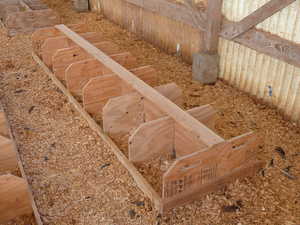
Our duck nest boxes (above). A 1"x4" along the top and both fronts. Use screws, not nails to hold together.
The next box rolled to show the bottom. (below)
The next box rolled to show the bottom. (below)
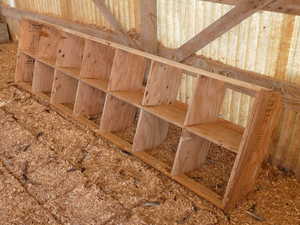
Notice how we have cut slots in the plywood so the nest walls slide into the nest back. No nails or screws are used to hold these parts together. It is just the 1x4s along the top and fronts that are screwed. Use at least 1/2" plywood.
Your birds may be very protected from predators but their instinct still tells them to hide their nest. For this reason you will want sides and a back on the nest.
Back it against a wall or fence or put it in a corner. If it is outside, it will definitely need a top for protection from the weather.
We have tried various styles of goose nests and so far the plastic barrel is the best. The advantages it has over the wood A frame nests described below are:
We have also used wooden A frame style nests for our geese. To keep the eggs cleaner, we have put burlap and plastic feed bags on the bottom of the nest. Unfortunately geese tend to shred it. If you have concrete or wood floors, make sure you have plenty of bedding in the nest. There is no need for a wooden bottom.
To keep the eggs cleaner, we have put burlap and plastic feed bags on the bottom of the nest. This is fine with ducks but geese tend to shred it.
If you have concrete or wood floors, make sure you have plenty of bedding in the nest. There is no need for a wooden bottom.
Your birds may be very protected from predators but their instinct still tells them to hide their nest. For this reason you will want sides and a back on the nest.
Back it against a wall or fence or put it in a corner. If it is outside, it will definitely need a top for protection from the weather.
We have tried various styles of goose nests and so far the plastic barrel is the best. The advantages it has over the wood A frame nests described below are:
- It is inexpensive. We found these used barrels for $8 each.
- They are easy to make. All you need is a drill and saber saw or sawzall.
- It is easier to collect eggs from the barrel.
- The bedding stays in the barrel.
- They are almost indestructible.
We have also used wooden A frame style nests for our geese. To keep the eggs cleaner, we have put burlap and plastic feed bags on the bottom of the nest. Unfortunately geese tend to shred it. If you have concrete or wood floors, make sure you have plenty of bedding in the nest. There is no need for a wooden bottom.
To keep the eggs cleaner, we have put burlap and plastic feed bags on the bottom of the nest. This is fine with ducks but geese tend to shred it.
If you have concrete or wood floors, make sure you have plenty of bedding in the nest. There is no need for a wooden bottom.
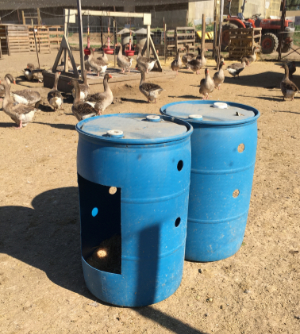
Note that we use blue barrels as that keeps it darker in the nest - which nesting birds prefer.
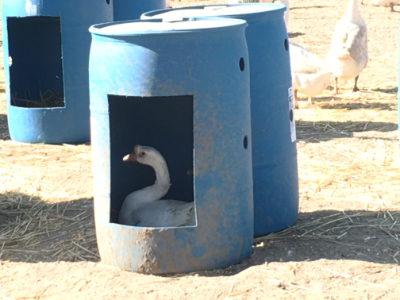
We drill some holes toward the top of the barrel to allow air circulation and we bolt two barrels together so they are less likely to tip.
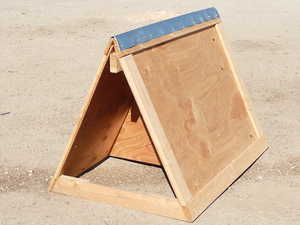
An unbedded goose nest. It just needs a coat of paint.
We use a layer of straw followed with shavings. Notice it is built for two geese, entering from either end.
We use a layer of straw followed with shavings. Notice it is built for two geese, entering from either end.
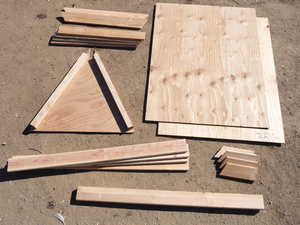
The parts of our goose nests. The nest is 48" long. Plywood pieces are 36"x48". "Threshhold" is 31" long. To save weight, all is 1x4 lumber except the ridge (2x4) and support lumber (2x2) on center divide.
Kathy Hopkins, who commented below, sent us pictures of some of her goose nests.
Kathy Hopkins, who commented below, sent us pictures of some of her goose nests.
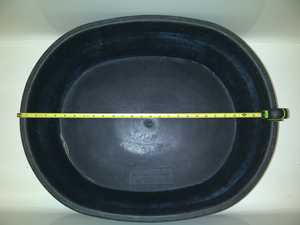
Tractor Supply Tuff Tub, 28"x22" x 8" deep. About $20. Perfect size for geese.
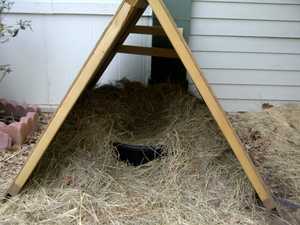
Kathy's A Frame goose nests. Notice the tub for the goose.